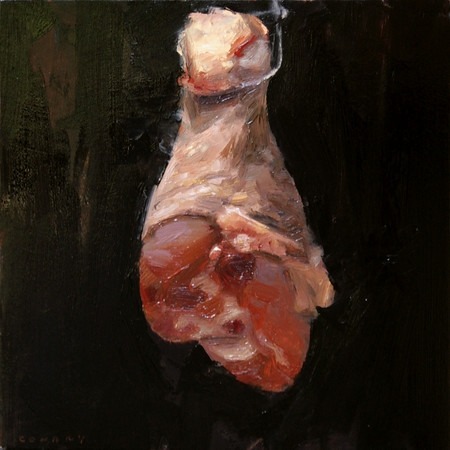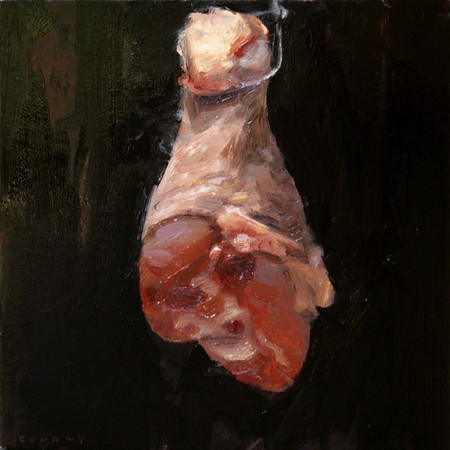Beef, It's What's For Still Life
In the annals of art history, meat as still life isn't unheard of, but it might not be the first subject that comes to mind —at least for most people. Scott Conary is not most people. For several years, the artist has focused on meat — painting cuts from lambs, pigs, and chickens. His work, featured in shows in two cities on opposite coasts, has been getting noticed. In this interview Conary discusses meat as subject, his favorite cuts, and where to eat the best meat in Portland. Don't miss the slideshow featuring his work.
How long have you been painting meat?
I painted the first small pork chop some three years ago after walking by the meat counter one too many times.
You're not a secret vegetarian are you?
I lack the will power. At the smell of the first grill, it would be over.
What's your favorite meat and cut?
I'm rather pedestrian. I love the humble little lamb loin chop.
Favorite place to eat it in Portland?
Portland, as you know, has become quite the food town. We're very fortunate to have an ever changing list of new and better places. It's nearly impossible to choose a favorite when there are places like Russell Street Bar-B-Que, Screen Door, Pine State Biscuits, Tin Shed, Higgins, Pambiche, ¿Por Qué No?, and so on. Having said that, Petite Provence is about 100 yards from my front door. Their risotto cakes and eggs are hard to beat.
Hanging Drumstick. 8" x 8", Oil on Panel
You said, "you can only paint so many pears." And that meat is stunning and intriguing. How?
We have a complicated relationship with meat. On one hand, it's the centerpiece of meals and family gatherings for many of us: Thanksgiving turkey, the Christmas roast, steaks and burgers on the grill for the 4th of July. Delicious and sometimes expensive, we celebrate the beautiful cut of the animal raised in the exact right way, and make a big deal out of consuming its flesh.
On the other hand there are common fears, practices, and also a desensitizing compartmentalization. For instance, "You'd better wash up fourteen times while working with that chicken." Or, "be sure to cook it to X degrees or else!" And, "when I'm shopping, please place it in a neat little package so that I don't have to think of what it used to be." There's also pressure to eat it in moderation, and concerns about our cholesterol and the environment. We're guilty, and scared, and beguiled. Lastly, we too are flesh. There's a scent of our own mortality when we consider a piece of meat. In comparison, for me, a piece of fruit is little more than a sweet taste and a pleasing shape.
What about the shapes and colors of the bones makes this appealing subject matter to you?
I love it when a painting has mass and form, and there isn't much that feels more substantial than a piece of meat. Beyond that, there's just so much going on in, for example, a lamb chop. The muscle, somewhat translucent, can shift in color from a deep brown to a rosy red. Here and there, flecks of the brightest scarlet. The fat will be opaque and blue to vanilla. The marrow can be almost orange. The contrasts continue from the texture of that marrow to the sharp blade of the bone to the weight of the meat itself. It sounds a bit peculiar saying it out loud like that.
Where did your inspiration come from?
I started working on some small still lifes a few years ago as a way to get back to the basics of form, color, and light after watching my friend Shawn Kenney, do the same.The immediacy of the still life, of quickly painting that thing in front of me, was a big change from the improvised landscapes and figurative work that I'd been doing and was far more rewarding than I'd anticipated.
I haven't, however, made a point of looking to the still lifes of other painters. Painting is painting, no matter the subject. You find something that says something to you, and get to work. This is, to my mind, the painting of my heroes — DeKooning, Degas, Rembrandt, Goya and so many more. It isn't about deliberately mincing your way through a painting as a delicate and deliberate science experiment. It's just doing it, digging in and pulling up some of that basic mysterious stuff that makes us human.
If you could ask your heroes anything about painting meat what would it be?
If they'd join me for a glass of wine afterwards.
So far you've painted poultry, lamb and steak, right? Any others I've missed?
You won't find much steak in my portfolio, but a lot of pork and lamb.
Which different cuts have you painted?
Mostly I've painted those cuts you could find at most any grocery store — beef and pork ribs, lamb chops, pork chops, shoulder, rib-eye, etc. The list isn't as long as I'd like, but it's about to get a bit longer as I've started working with Camas Davis. She runs a series of butchery classes here in Portland. A few weeks ago I got to sit in while a former OSU professor of Meat Sciences expertly carved a steer forequarter.
Which are your favorite cuts, types of meat to paint and why?
The lamb chop, a favorite to eat, is a favorite to paint. There's probably a connection there, but otherwise they've got a great structure and color.
Where do you procure your meat from?
We've got a fantastic local grocery store chain, New Seasons Markets, that sells almost entirely meat from local and grass-fed animals.
You have two concurrent shows in the Portlands, one in Maine (Fresh Cuts), the other in Oregon (Meat). You live in Oregon — why the parallel with Maine?
Pure coincidence. We've had an challenging year in our family that greatly impacted my ability to put paint to canvas. When the opportunity to turn out work for these two shows came up, I jumped.
Is there a specific meaning, thought, or feeling that you hope to evoke in those engaging with your pieces as they observe and walk away from them?
I believe, at their best, the paintings are made so that there's room for the viewer to respond in their own particular way. I want them to feel the weight of the subject, to have it resonate with them in some basic or primal kind of way, and just feel right.
What question about your paintings do you wish you were asked?
"Would you consider $1,000,000 for the pork chop?" The response to these pieces has been strong and most every question you can think of, aside from the million dollar one, gets asked.
You're from Pennsylvania — do you have a favorite place there for a cheesesteak?
When it comes to my home state, I've always been more of a pretzel guy.
Who makes the best pretzels back home?
Martin's, or any of the old family run pretzel makers out in Lancaster county.

